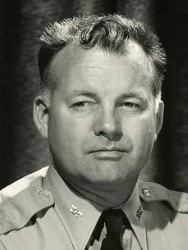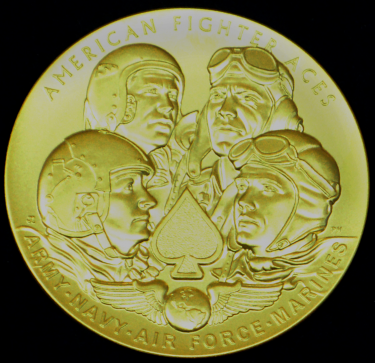
 |
|
|
||
|
Glenn Todd Eagleston |
||||
|
Engagements: • World War II (1941 - 1945)• Korean War (1950 - 1953) |
||||
| Biography: | ||||
|
Glenn Todd Eagleston Glenn Todd Eagleston was born on 12 March 1921 in Farmington, UT. In 1940, he enlisted in the the U.S. Army Air Corps as a Private and became an Aviation Cadet in 1942. He graduated at Luke Field, Phoenix, AZ, in September 1942 and was commissioned as a Second Lieutenant in the Air Corps with the rating of Pilot. 2LT Eagleston's first assignment was with the 79th Fighter Squadron, 20th Fighter Group, flying the P-39 Airacobra. In January 1943, he was transferred to the 353rd Fighter Squadron, 354th Fighter Group, which deployed to England in October 1943 and was assigned to the Ninth Air Force in December. The 354th Fighter Group was the first to fly P-51 Mustangs operationally, receiving their Merlin-powered P-51Bs in November. The 354th was attached to the Eighth Air Force for bomber escort duty and, in those missions they pushed to find the long-range limits of the P-51 aircraft. The 354th flew through the bad winter weather of 1943-44, typically dividing its three squadrons into 4 color-coded flights of 4 P-51s each. During that time, 1LT Eagleston quickly became one of the 353rd Fighter Squadron's outstanding pilots. On 5 January 1944, the Group was covering bomber withdrawal from Kiel, Germany, when they engaged a gaggle of German Luftwaffe fighters. Flying at 23,000 feet, 1LT Eagleston caught a Focke-Wulf 190 with a short burst, at 45 degrees of deflection. The enemy aircraft dove away steeply and 1LT Eagleston pursued. Both planes accelerated rapidly and the German went into a violent, unrecoverable spin. Crashing into the ground, the Focke Wulf-190 became Eagleston's first victory - although 1LT Eagleston said his gun fire might not have even hit it. On that mission, the Group's fighters claimed 18 enemy aircraft shot down. 1LT Eagleston's score climbed steadily that winter and, by 6 March, he was an Ace with 5 kills. In the spring of 1944, the 354th returned to its original tactical role in preparation for D-Day. In mid-June, the Group moved to Cricqueville-en-Bessin, an advanced base in Normandy, France, and also returned to the command of Ninth Air Force. At this time Eagleston had been promoted to Captain and had 8.5 confirmed aerial victories. He had finished his first combat tour and was out of action for the summer. He returned to active duty in the fall and, on 29 August 1944, CPT Eagleston's Group was in aerial combat against German forces in the European Theater of Operations when he shot down 3 German Messerschmitt Bf-109 aircraft in a single mission. CPT Eagleston’s flying skills, courageous actions and extraordinary heroism that day earned him the U.S. Army's second highest award for valor, the Distinguished Service Cross. Before the above mission that earned him the DSC for shooting down 3 aircraft in a single mission, Eagleston was already a Double Ace with 13.5 victories. In October 1944, CPT Eagleston took command of the 353rd Fighter Squadron that was now equipped with P-47D Thunderbolts. They flew their first mission on 26 November and continued to fly close-support, armed-reconnaissance, fighter-sweep, dive-bombing, strafing, and escort missions. On 16 February 1945, the 353rd Fighter Squadron returned to flying P-51 Mustangs. CPT Eagleston was credited with 18.5 aerial victories, 2 probables, and 7 damaged German aircraft. He also destroyed at least 5 enemy aircraft on the ground. Eagleston finished WWII as a Triple Ace with 18.5 aerial victories, and was the Ninth Air Force's Top Ace. He remained in the military and transferred to the newly-established U.S. Air Force in 1947. The Inter-War Period From February to June 1946, Eagleston served as Assistant Director of Operations and Training at Dover Field, Dover, DE, and then as Commander of Dow Army Airfield, Bangor, ME, from July to September. In January 1947, Eagleston completed Jet Fighter Pilot School at Williams Field in Maricopa County, AZ, and then served at Newark Army Airfield, Newark, NJ, until February 1949. He served as Operations Officer for the 33rd Fighter Group at Otis Air Force Base at Cape Cod, MA, from February to July 1949, and then attended Air Command and Staff School at Maxwell Air Force Base, AL, from July 1949 to January 1950. He was then made Commander of the 60th Fighter Squadron at Otis Air Force Base, where he served until November 1950. Korea When the war broke out in Korea, Eagleston returned to combat as Commander of the 334th Fighter Interceptor Squadron in Korea. In May 1951, he became Commander of the 4th Fighter Interceptor Group. On 22 December 1950, in one of the earliest dogfights, Eagleston downed his first MiG-15 over the Yalu River. His F-86A fighter was badly damaged by a MiG-15 flown by Sergei Kramarenko on 17 June 1951, and he was forced to belly-land at Kimpo Air Base, near Seoul, South Korea. The jet was damaged beyond repair and was written off. The leader of 2 Sabres who came to assist Eagleston was also a notable combat pilot: Lt. Col. Bruce Hinton, the first Sabre pilot to shoot down a MiG-15 on 17 December 1950. Eagleston returned to the United States in September 1951. During his time there, he flew 84 missions, destroyed 2 MiG-15s, had 1 probable, and damaged 7. This brought Eagleston's his total to 20.5 enemy aircraft destroyed in aerial combat during his career. Peacetime Assignments After his return to the U.S. in September 1951, he was Commander of the 103rd Fighter-Interceptor Group, and then Deputy Base Commander, at Suffolk County Air Base in Long Island, NY, until April 1952. Next, he was Director of Operations and Training at Headquarters Eastern Air Defense Force at Stewart Air Force Base, NY, from April 1952 to October 1953, when he became Commander of the 4750th Training Group at Vincent Air Force Base at Yuma, AZ. Eagleston became Deputy Commander of the 4750th Air Defense Wing, also at Vincent AFB, in June 1955. Colonel Eagleston then served as Director of Operations of the 313th Air Division followed by duty as Commander of the 6313th Air Base Wing, both at Kadena Air Base, Japan, until July 1960. From July 1960 to April 1962, he was Base Commander for the 4756th Air Defense Group at Tyndall Air Force Base, Panama City, FL. This was followed by duty as Deputy Commander and then Commander of the 2478th Air Force Reserve Sector at Long Beach Municipal Airport, CA, from April 1962 to July 1965, when he became Director of Maintenance for the 25th Air Division at McChord Air Force Base, WA. His final assignment was as Director of Material for Seattle Air Defense Sector at McChord Air Base, from February 1966 until his retirement. Eagleston retired on 28 February 1967 as a U.S. Air Force Colonel. Medals, Awards and Badges Distinguished Service Cross Distinguished Service Cross Citation (Synopsis) Captain (Air Corps) Glenn Todd Eagleston (ASN: 0-730417/9438A), United States Army Air Forces, was awarded the Distinguished Service Cross for extraordinary heroism in connection with military operations against an armed enemy while serving as Pilot of a P-51 Fighter Airplane in the 353d Fighter Squadron, 354th Fighter Group, NINTH Air Force, in aerial combat against enemy forces on 29 October 1944, in the European Theater of Operations. On this date Captain Eagleston shot down three enemy aircraft in a single mission. Captain Eagleston's unquestionable valor in aerial combat is in keeping with the highest traditions of the military service and reflects great credit upon himself, the 9th Air Force, and the United States Army Air Forces. General Orders: Headquarters, U.S. Strategic Forces in Europe, General Orders No. 13 (1945) Congressional Gold Medal The Congressional Gold Medal, created by the U.S. Mint, is the highest civilian honor Congress can give on behalf of the American people. On 20 May 2015, leaders from the U.S. House of Representatives and Senate presented the Congressional Gold Medal [see photo] to the American Fighter Aces Association at the U.S. Capitol Visitor Center Emancipation Hall. More than 60,000 American fighter pilots engaged in aerial combat during World War I, World War II, the Korean War and the Vietnam War. Of those pilots, only 1,447 earned the title of fighter “Ace” by downing at least five enemy aircraft. Colonel Glenn Todd Eagleston was one of them, having been credited with 20.5 aircraft shot down in aerial combat, making him a Quadruple Ace. At the time of the presentation of the Medal, only 75 of those Aces remained alive. Death and Inurnment Colonel Glenn Todd Eagleston died on 7 May 1991. His ashes are inurned at the Arlington National Cemetery Columbarium, in Arlington, Arlington County, VA, in Section 3-G, Row 5, Site 5. https://www.findagrave.com/cgi-bin/fg.cgi?page=gr&GRid=65148127 |
||||
| Honoree ID: 312804 | Created by: MHOH | |||
Ribbons
Medals
Badges
Honoree Photos
 |  |  |
 |  |
 |


